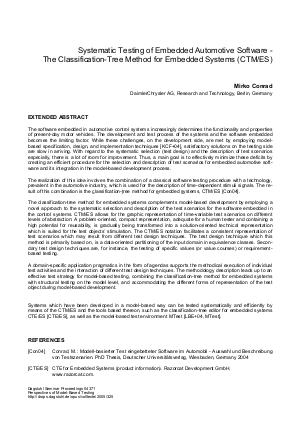Systematic Testing of Embedded Automotive Software - The Classification-Tree Method for Embedded Systems (CTM/ES)
Author Mirko Conrad
-
Part of:
Volume:
Dagstuhl Seminar Proceedings, Volume 4371
Part of: Series: Dagstuhl Seminar Proceedings (DagSemProc) - License:
 Creative Commons Attribution 4.0 International license
Creative Commons Attribution 4.0 International license
- Publication Date: 2005-11-28
Files

PDF
DagSemProc.04371.4.pdf
- Filesize: 213 kB
- 2 pages
PDF
DagSemProc.04371.4-add.pdf
- Filesize: 467 kB
Document Identifiers
Subject Classification
Keywords
- Model-based Testing
- Classification-tree Method for Embedded Systems (CTM/ES)
- test design technique
- test notation
Metrics
- Access Statistics
-
Total Accesses (updated on a weekly basis)
0Document
0Metadata
Abstract
The software embedded in automotive control systems increasingly determines the functionality and properties of present-day motor vehicles. The development and test process of the systems and the software embedded becomes the limiting factor. While these challenges, on the development side, are met by employing model-based specification, design, and implementation techniques [KCF+04], satisfactory solutions on the testing side are slow in arriving. With regard to the systematic selection (test design) and the description of test scenarios especially, there is a lot of room for improvement. Thus, a main goal is to effectively minimize these deficits by creating an efficient procedure for the selection and description of test scenarios for embedded automotive software and its integration in the model-based development process. The realization of this idea involves the combination of a classical software testing procedure with a technology, prevalent in the automotive industry, which is used for the description of time-dependent stimuli signals. The result of this combination is the classification-tree method for embedded systems, CTM/ES [Con04]. The classification-tree method for embedded systems complements model-based development by employing a novel approach to the systematic selection and description of the test scenarios for the software embedded in the control systems. CTM/ES allows for the graphic representation of time-variable test scenarios on different levels of abstraction: A problem-oriented, compact representation, adequate for a human tester and containing a high potential for reusability, is gradually being transformed into a solution-oriented technical representation which is suited for the test objects' stimulation. The CTM/ES notation facilitates a consistent representation of test scenarios which may result from different test design techniques. The test design technique which this method is primarily based on, is a data-oriented partitioning of the input domain in equivalence classes. Secondary test design techniques are, for instance, the testing of specific values (or value courses) or requirement-based testing. A domain-specific application pragmatics in the form of agendas supports the methodical execution of individual test activities and the interaction of different test design techniques. The methodology description leads up to an effective test strategy for model-based testing, combining the classification-tree method for embedded systems with structural testing on the model level, and accommodating the different forms of representation of the test object during model-based development. Systems which have been developed in a model-based way can be tested systematically and efficiently by means of the CTM/ES and the tools based thereon, such as the classification-tree editor for embedded systems CTE/ES [CTE/ES], as well as the model-based test environment MTest [LBE+04, MTest].
Cite As Get BibTex
Mirko Conrad. Systematic Testing of Embedded Automotive Software - The Classification-Tree Method for Embedded Systems (CTM/ES). In Perspectives of Model-Based Testing. Dagstuhl Seminar Proceedings, Volume 4371, pp. 1-2, Schloss Dagstuhl – Leibniz-Zentrum für Informatik (2005)
https://doi.org/10.4230/DagSemProc.04371.4
BibTex
@InProceedings{conrad:DagSemProc.04371.4,
author = {Conrad, Mirko},
title = {{Systematic Testing of Embedded Automotive Software - The Classification-Tree Method for Embedded Systems (CTM/ES)}},
booktitle = {Perspectives of Model-Based Testing},
pages = {1--2},
series = {Dagstuhl Seminar Proceedings (DagSemProc)},
ISSN = {1862-4405},
year = {2005},
volume = {4371},
editor = {Ed Brinksma and Wolfgang Grieskamp and Jan Tretmans},
publisher = {Schloss Dagstuhl -- Leibniz-Zentrum f{\"u}r Informatik},
address = {Dagstuhl, Germany},
URL = {https://drops.dagstuhl.de/entities/document/10.4230/DagSemProc.04371.4},
URN = {urn:nbn:de:0030-drops-3257},
doi = {10.4230/DagSemProc.04371.4},
annote = {Keywords: Model-based Testing, Classification-tree Method for Embedded Systems (CTM/ES), test design technique, test notation}
}
